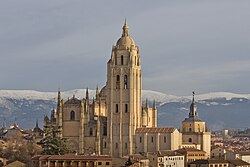Thirteenth century
In the mid-thirteenth century the Diocese of Segovia underwent a major reorganization of its finances and governance. Following the Fourth Lateran Council (11 November 1215), which had called for moral and administrative reform across Christendom, the diocese resisted efforts to regulate clerical life. Local clergy withheld tithes, concubinage was widespread, and disputes erupted between bishop and chapter over control of revenues, all while royal taxation for the Reconquista and the construction of a new cathedral placed additional strain on diocesan resources. [4]
To address these problems, Cardinal Gil Torres, acting for Pope Innocent IV, intervened in the 1240s. He ordered surveys of diocesan possessions in Segovia, as he did elsewhere in Castile, with the aim of clearly defining the income of bishops, dignitaries, and canons. A provisional division of revenues was issued in October 1245, but it proved inadequate. A more complete survey was then carried out by the archdeacons of Segovia and Sepúlveda together with the abbot of Sotos Albos, and completed by 30 April 1247. On 1 June 1247 Bishop Bernardo and the chapter agreed on a definitive allocation of rents, and on 14 September Cardinal Gil confirmed the settlement. [4]
The resulting manuscript record, preserved in British Library MS Egerton 910, is exceptionally detailed for the period. It lists 542 parishes across the diocese, catalogues episcopal estates valued at 2,700 maravedís, and records newly assigned rents of about 2,300 maravedís. The text further distinguishes prebends, portions of tithes, and funds reserved for liturgical expenses, fabric repairs, and almsgiving. Its figures reveal striking inequalities: the average parish rector received less than 17 maravedís annually, while the bishop controlled an income nearly 300 times greater. Dignitaries such as the dean, archdeacons, cantor, treasurer, and magister scholarum were granted fixed stipends ranging from 170 to 370 maravedís, with ordinary canons receiving 50. [4]
In 1258 a set of episcopal-capitular statutes regulated the daily distribution of revenues and linked them to the performance of Mass and Vespers. They also assigned specific prebends to communal meals, vestments, and almsgiving, tying liturgical life to the diocese's economic base and ensuring that cathedral clergy benefited in proportion to their participation in worship and administration. On 25 January 1265 the cathedral chapter issued a formal declaration of resistance against any bishop who attempted to vary the ordinances of Cardinal Gil Torres. The document pledged the dean and canons to defend their rights collectively, to deny any new decimarius demanded by a bishop, and to require each new canon to swear an oath to uphold these statutes. This capitular ultimatum illustrates the enduring conflict between episcopal authority and the corporate privileges of the chapter, a theme that continued to shape diocesan life in Segovia through the later Middle Ages. [4]


